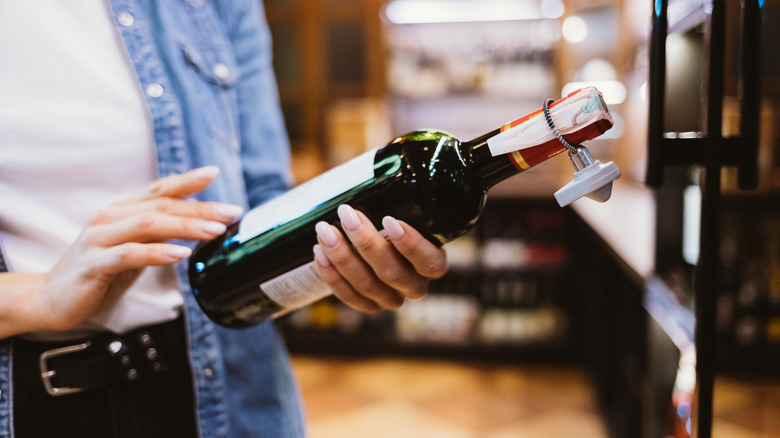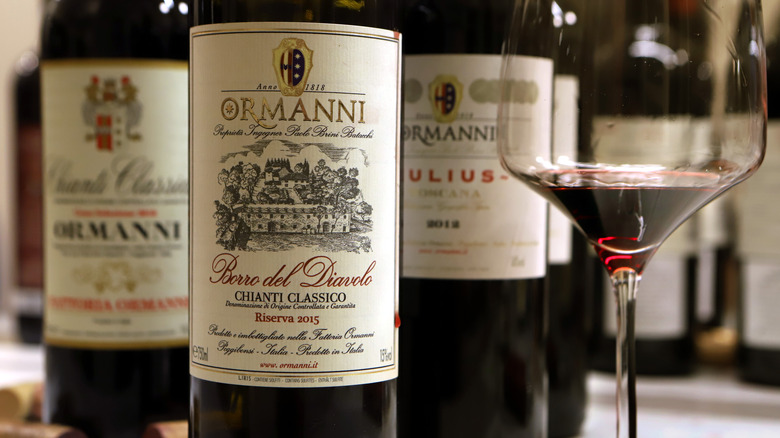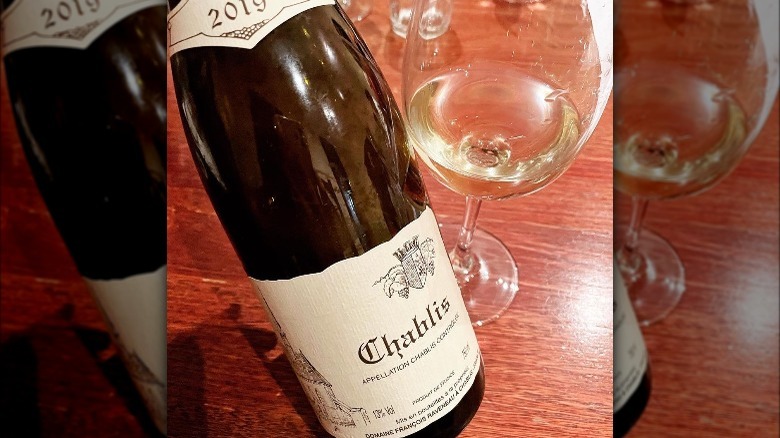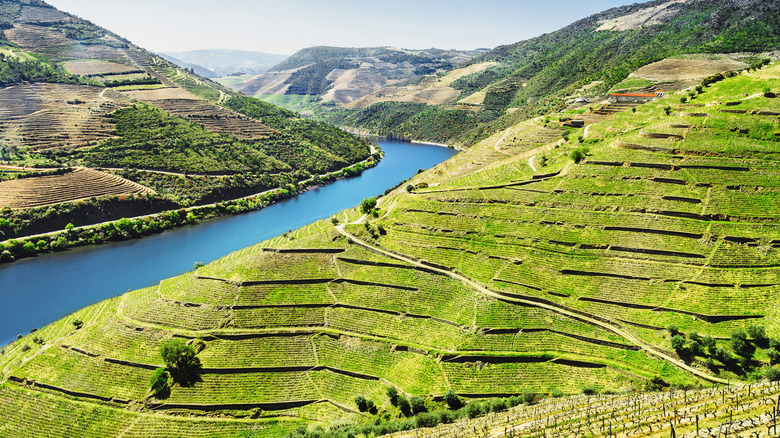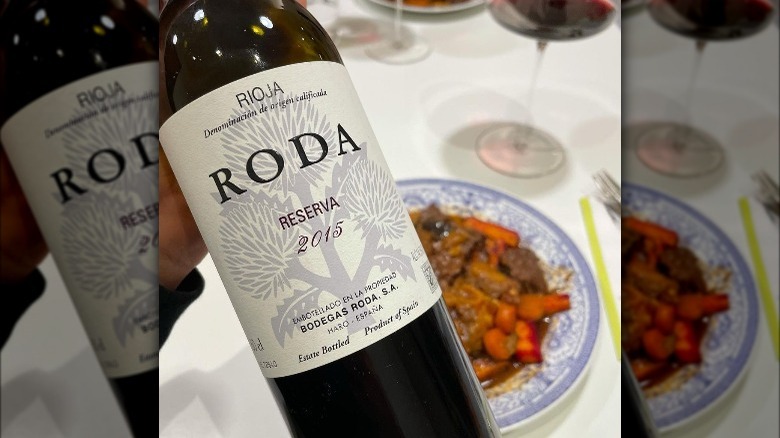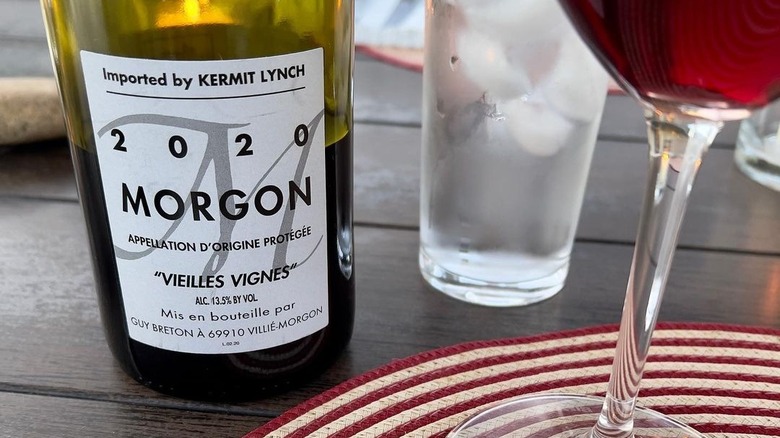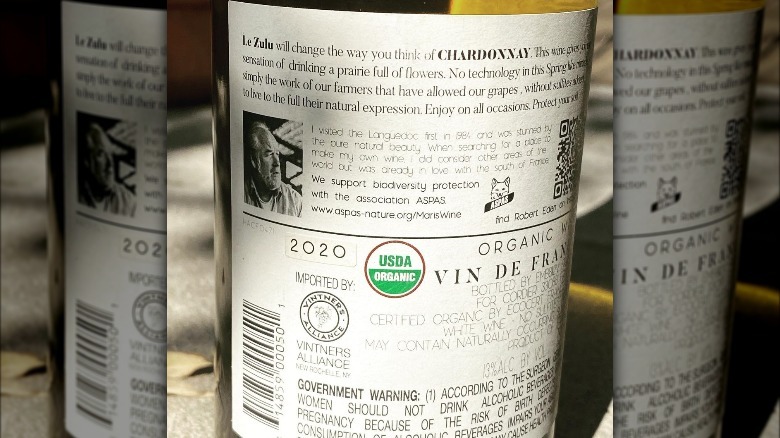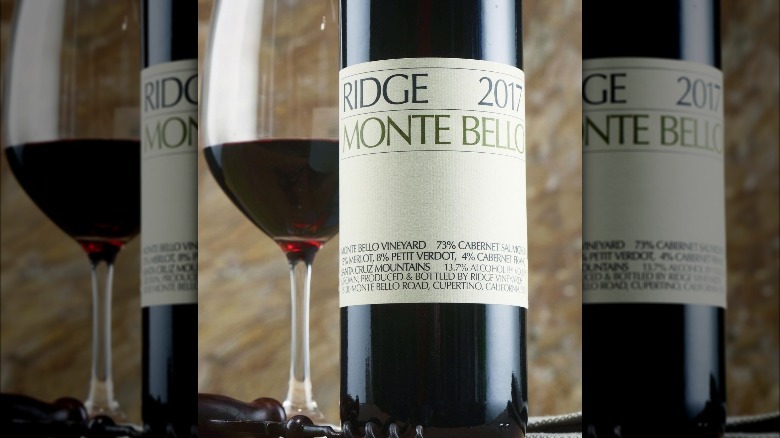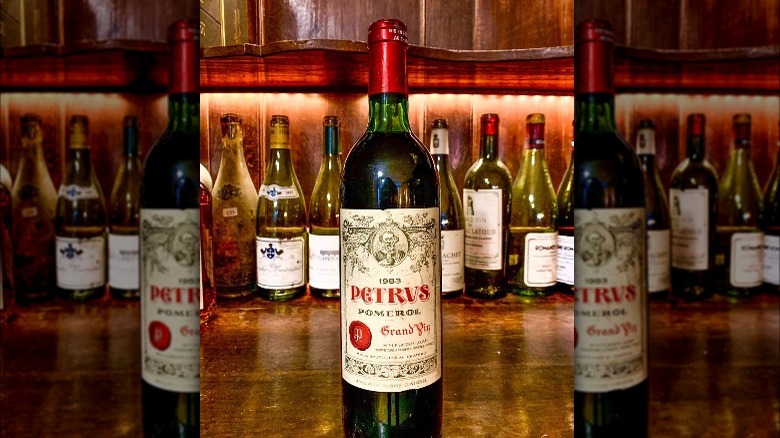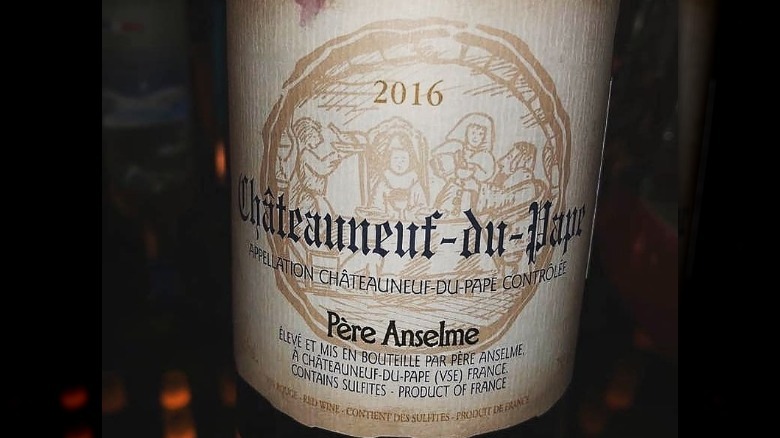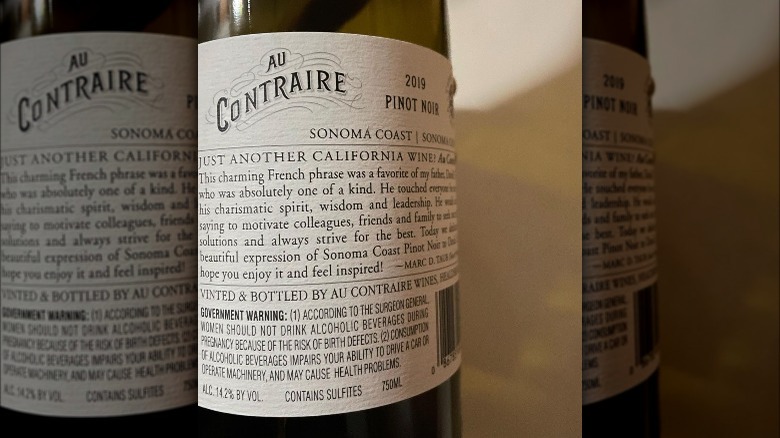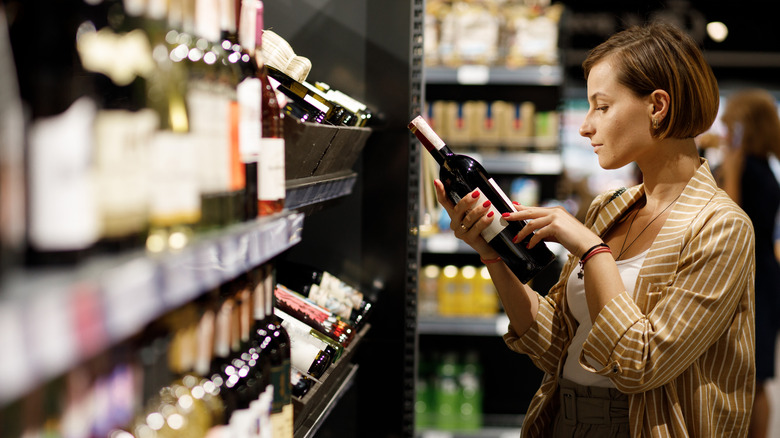How To Decode A Wine Label
Standing in front of a wall of wine bottles can sometimes feel like an indecipherable feat. With geographical regions you've never heard of, terms written in foreign languages, and either an abundance or total lack of information, it's hard to know what to expect. While you could spend years deep-diving into the vast world of wine to learn about its endless characteristics, that's not so realistic for the average wine drinker.
Nonetheless, without turning your love for wine into a full-blown educational moment (unless you want to), there are plenty of tips to simplify the process of reading bottle labels. We'll walk you through the differences between the old world and new world wine labeling (and what those two terms mean), some useful vocabulary to help you on your journey, and plenty of nuances of winemaking and viticulture that find their way on a bottle label. Once we're through, you'll be walking into wine shops with a totally new perspective.
Figure out if the label refers to a variety or a place
If all wine producers could agree to be consistent with labeling, it sure would make it easier for the average consumer. However, as to be expected given the vast range of the international market, that isn't quite the case. If you take a close look at a store shelf, you might notice that some bottles display the names of regions, whereas others indicate the grape variety. And of course, in some cases, it isn't too obvious which of the two is being referenced.
Thankfully, there is a certain level of consistency to what appears to be totally random. Typically — though not always or that would be too easy — wines from Europe (old world) specify regions, while those from everywhere else (new world) highlight grapes (per The Back Label). This follows from the fact that old world wines tend to have many more restrictions imposed on their production, narrowing the parameters of what you can expect to encounter.
Consequently, if you see a bottle labeled Chianti Classico, the assumption is that you know the region requires wines to be made with 80 to 100% Sangiovese — common knowledge, right? Nonetheless, exceptions are rampant, such as Barbera d'Asti, an Italian wine made with Barbera in Asti. Meanwhile, in the U.S., unless you're drinking very basic wine, you will see both a grape and regional designation splashed across the label, per the Alcohol and Tobacco Tax and Trade Bureau (TTB).
Learn some background on European wine-producing regions
As indicated, European wine labels often count on the assumption that you know the regulations for a given region. Of course, with the never-ending selection of places making wine on the continent, you'd have to study non-stop to know what you were drinking. Realistically, that isn't going to happen for most people, since reviewing lists of wine-making requirements before choosing a bottle isn't standard consumer behavior.
To avoid overwhelming yourself every time you walk into a wine store, a little bit of education can go a long way. Wine appellations designate a contained area with an overarching characteristic (geographical, historical, varietal) in common (per Usual Wines). Each country has its own rules and refers to them with local terms (DO, DOC, DOCG, AOC, etc.), so it's worth zooming in on the wine regions you gravitate toward in order to know what to expect.
For example, if you often buy French wine, learn about the main wine areas (Burgundy, Bordeaux, Champagne, etc.) Then, read up on what grapes are allowed to be used; for example, Burgundy whites are primarily made with Chardonnay while reds consist of Pinot Noir. Other regions are a little bit more complicated, such as the Southern Rhône, where dozens of grapes can make up any given blend. Ultimately, if you're drinking European wines, it's worth diving into your favorite regions to learn the basics.
See if you can zoom in on the geographical specifics
Given that it's unlikely you'll keep all of the facts straight (unless you're studying for a certification that demands it), having additional tricks to make some inferences will get you far. Understanding certain geographical aspects of a wine appellation can provide you with information regarding climate, topography, and proximity to water (per Wine & Spirit Education Trust, WSET). All of these components highly influence the style of wine being produced in any given area.
Take latitude: Regions closer to the equator are warmer and consequently, grapes grown in these areas ripen more quickly. Meanwhile, the opposite is true about places further from the equator. Altitude also plays a large role, such as by offering heat relief in hot regions. Large bodies of water provide a similar effect, cooling summer heat and tempering winter cold. Taking it a step further, if you know that a vineyard is close to a volcano, for example, you'll be able to ascertain additional clues about the type of soil the grapes grow in.
Start broadly by considering whether a region is landlocked or by the sea, then go from there. There are plenty of environmental clues that can help you determine whether your Chardonnay will taste rich and tropical or crisp and mineral.
Acquaint yourself with specific wine terms
As you explore the world of wine, having additional vocabulary (some foreign) will significantly help you understand what's on any given label. Again, instead of inundating your brain with an endless list of words, zoom in on specific countries for focus. Typically, Europe has stricter definitions, while new world countries are sometimes looser with words.
Thankfully, American wine labels are in English, so that avoids one issue, however, terms like reserve or old vines can leave you puzzled. More so, since oftentimes, these aren't regulated across the board; whereas in the U.S., reserve has no official designation and might imply an older higher-quality wine (per VinePair), in Spain's Rioja DOC, a reserva wine must meet specific aging requirements.
In Burgundy, France, you'll have some insight into the value of a bottle if you can distinguish between a Bourgogne AOC wine or a Grand Cru. (Hint: The latter will cost more but must also meet rigorous restrictions in the vineyard and cellar.) Similarly, knowing that Bordeaux refers to a winery as a château (which means castle in French, though it probably won't look like one) and Burgundy as a domaine, per Wine Spectator, can help eliminate some of the noise on a label. Meanwhile, if you're a fan of German wines, you might want to dedicate some time to understanding the various levels of ripeness (Kabinett, Spatlëse, Auslese, etc.), as well as important terms like trocken, which indicates a wine is dry.
Focus on the nuances of sparkling wine
If bubbles are your thing, take the time to dig deeper into the different styles and how they are indicated on bottle labels. For starters, the method of production is usually mentioned; look for traditional, Charmat, tank, and champenoise, among others, to understand how the secondary fermentation (the one that makes bubbles) was performed (per Beverage Dynamics).
Meanwhile, sparkling wine can be made in a wide range of sweetness levels, from doux or mild, aka very sweet, to brut nature, which indicates no added sugar (per Decanter). The terms are regulated differently depending on the region of production, but the order of sweetness tends to follow the same path. Between these two extremes lie a number of styles of sparkling wine, and it might not be so obvious that a bottle labeled brut is in fact less sweet than one labeled extra dry (per VinePair). Logical, right?
Look to the importer for additional information
Per the TTB, international wine must go through an importer in order to be sold in the U.S. Whereas some are large, faceless corporations that are primarily in it for the business, many smaller importers are passionate people seeking to share wines that highlight the characteristics of a given place. If you want to hone in on certain regions or styles of wine without having to taste plenty of flops along the way, your best bet is to seek out an importer with similar ideals.
Research wine importers in the U.S. and add qualifiers such as natural, organic, and geographical regions to give your search more focus. As VinePair points out, many importers have their own niche, making it an easy way to source more products you're likely to enjoy. If you pay attention to bottle labels, you'll notice that the name and address of the importer are always indicated, per the TTB. Begin to familiarize yourself with who is importing the wines you most enjoy. Then, make a point to choose other wines from them and you may discover something new.
Identify any certifications
As controlled by the TTB, wine labels require a number of elements in order to be allowed on the market. However, the list doesn't stop there when it comes to additional certifications. Producing organic, biodynamic, and sustainable wine is on the radar for many winemakers. While their intentions might be aligned with this pursuit, in order to highlight these characteristics on bottle labels, proper certification is required. This guarantees consumers that a product is made in accordance to requirements and it keeps producers accountable.
Certifying bodies are often specific to a country, so whereas the USDA approves organic wine in the U.S., in France both Agriculture Biologique and regional organizations are in charge. Consequently, the standards for what is considered organic can differ depending on the country. Even within the U.S., terms like 100% organic (no sulfites added), 100% organically grown grapes, and made with organic grapes (minimum 70%), have a number of nuances.
Biodynamic viticulture (a holistic approach that aims to create harmony in the environment) is primarily certified by Biodyvin in some European countries and Demeter International. Sustainable agriculture has its own slew of certifications, such as LIVE (Low Input Viticulture & Technology) and SIP (Sustainability in Practice). Meanwhile, regenerative agriculture might be indicated with a certification by A Greener World, and winery buildings with the LEED certification are built with ecological and energy saving considerations. Even vegan wine comes with its own stamp of approval.
Understand how the alcohol level indicates what to expect
Again, the TTB has the last say on many elements of wine labels, and the alcohol content is most certainly one of them. For wines under 14% abv, a specific figure needs to be indicated, unless the product is classified as table wine or light wine. Above 14%, numbers need to be displayed. Aside from knowing how tipsy you'll get from a few glasses of the stuff, alcohol content can provide you with extra information about a wine.
According to Wine Folly, high alcohol wines (15% and over) are likely fortified or produced with extremely ripe grapes. Not only does ripeness affect sugar and consequently alcohol levels, but it also influences the taste of the fruit and wine. Consider the difference between a tart plum and one that is juicy and brimming with rich flavor. Meanwhile, an alcohol content under 10% is a clue that a wine will have a light body and be slightly sweet, since not all of the sugar from the grapes has been fermented.
Find out if the vintage plays an important role
It might seem that the biggest factor in ascertaining the quality and value of a wine is its vintage or year of harvest. After all, vintage Champagne is a prestigious product, and it seems as though Bordeaux wines are always referred to by year. Besides indicating the age of a bottle, in some cases, vintage can provide relevant information about a wine.
Primarily, what varies the most over any given year are the weather conditions throughout the season up until harvest (per Wine Folly). Was the summer sufficiently sunny for the grapes to ripen or was it so cold that the fruit didn't develop enough sugar? Was the climate hot and dry or did it rain nonstop leading to issues with mold?
However, as Wine Folly points out, the significance of vintage varies depending on the region of the world. For example, places with finicky and highly variable weather, such as Champagne, Burgundy, and Bordeaux in France, Piedmont in Italy, and Rioja in Spain, rely more heavily on good conditions. Meanwhile, California, Portugal, and Australia are some regions where the sun can usually be counted on to properly ripen the fruit. Additionally, unless you're planning on storing wine for a length of time or are purchasing old wine from a particular vintage (in which case a vintage chart is a good resource), producers don't aim to sell terrible wine — it may simply have undergone a few additional corrections in the cellar.
Recognize the importance of the sulfite debate
Sulfites have been at the center stage of many arguments concerning wine additives, hangovers, and headaches. While there are naturallly occurring quantities of the compounds in vineyards and wineries, their use as a preservative is a point of contention between natural and so-called conventional winemakers (per Decanter). In fact, there are far more additives legally permitted in wine, as first widely revealed by natural wine writer Alice Feiring of The Feiring Line, but most of them don't need to be mentioned on the label.
On the other hand, sulfites are required to be indicated on wines containing 10 or more parts per million, according to the TTB. Meanwhile, products containing less than this amount or a total absence of sulfites (confirmed by lab testing) have the option to indicate this fact on the label. This tiny detail has struck the consumer's eye, leading to the vilification of what in low amounts is intended solely to ensure a wine is properly preserved once bottled. The label is required since between 1 in 40 and 1 in 100 people are sensitive to sulfites, especially if they are asthmatic (per Cleveland Clinic). As you'd expect from this correlation, the symptoms are primarily respiratory — no headaches in sight.
What can be learned from the producer's notes
Producers who are eager to expand consumer knowledge are sure to include information regarding vineyards, grape varieties, seasonal conditions, and cellar activity on their labels. They may also provide tasting notes and food pairing suggestions to give customers the complete picture. Say a producer raves about how the wine's qualities make it an ideal match for a juicy grilled steak — perhaps you won't choose it if you're having a light seafood dinner.
Often, technical terms are favored for precision, so once again having some background vocabulary can help you make sense of the various notes. If you want to dig a little deeper, many winery websites include tech sheets for their wines that go into more detail about the overall process. Even when it comes to flavor, subjectivity and ambiguity can make the details uncertain. As Decanter outlines, grasping some basic concepts such as oak, tannin, and a range of fruit flavors can guide you toward understanding how a bottle of wine is likely to taste.
Decide whether it's worth your time
Producers who invest their time to make quality wines are usually keen to share their journey with customers. By highlighting what went on in the vineyard and cellar, as well as how it pans out in the glass, winemakers can inspire consumers to make a purchase. That being said, if you find a bottle with limited information pertaining to the wine, it might not be something special.
If the most a producer can say is that it's "wine o'clock somewhere," perhaps it isn't going to wow you with its complexity. Nonetheless, some occasions call for exactly that bottle, while other times something with a bit more depth both on the label and in the glass is desired. Ultimately, there's no right or wrong and the same person can be satisfied with a certain wine one day and want something else the next. Mixing wine for sangria? Perhaps a Burgundy Grand Cru isn't so relevant in this case, whereas you might splurge and get a bottle for an anniversary dinner. Regardless, knowledge is power, as they say, and understanding a label can help you better locate a wine that will suit your tastes for that particular moment in time.
